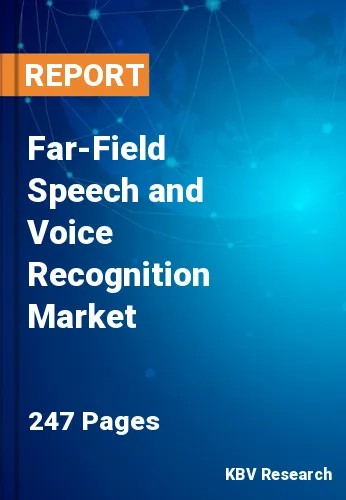The Global Far-Field Speech and Voice Recognition Market size is expected to reach $9 billion by 2030, rising at a market growth of 13.8% CAGR during the forecast period.
Robotics is one of the growing applications of far-field speech and voice recognition as the development of home robots has grown dependent on far-field speech and voice recognition technologies. Consequently, Robotics is anticipated to generate approximately 1/4h share of the market by 2030. Consumers are increasingly interested in using household robots to automate repetitive jobs and enhance their quality of life. The capabilities of home robots may be significantly improved by far-field speech and voice recognition technologies, making them more logical and user-friendly. The accuracy and effectiveness of far-field speech and voice recognition technologies have substantially increased because of developments in AI and natural language processing (NLP).
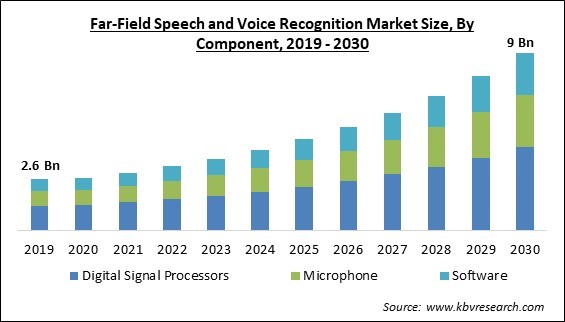
The major strategies followed by the market participants are Product Launches as the key developmental strategy to keep pace with the changing demands of end users. For instance, In February, 2020, NXP announced the launch of SLN-LOCAL-IOT, a completely integrated development platform for offline voice control. The launched voice solution includes a full hardware module design and connected software needed to implement far-field voice control with tailored wake words and local commands. Additionally, In February, 2022, Synaptics Incorporated launched SYN4381 Triple Combo soc with combined Wi-Fi 6/6E, Bluetooth® 5.2 and 802.15.4/Thread for Seamless IoT Connectivity. The launched SOC and its supporting SynFiTM software ease product development and decrease time to market, as well as boost the transformation to secure, scalable and seamless connectivity between devices.
Based on the Analysis presented in the KBV Cardinal matrix; Harman International Industries, Inc. (Samsung Electronics Co., Ltd.) are the forerunners in the Market. In June, 2023, HARMAN Professional Solutions announced the launch of CE Series, a series of professional-grade Universal Control Extenders. The launched series offers AMX-quality hardware control to any system that backs IP connectivity, making these units perfect for colleges and universities, corporate spaces, and government facilities. Companies such as Synaptics Incorporated, NXP Semiconductors N.V. and Infineon Technologies AG are some of the key innovators in the Market.
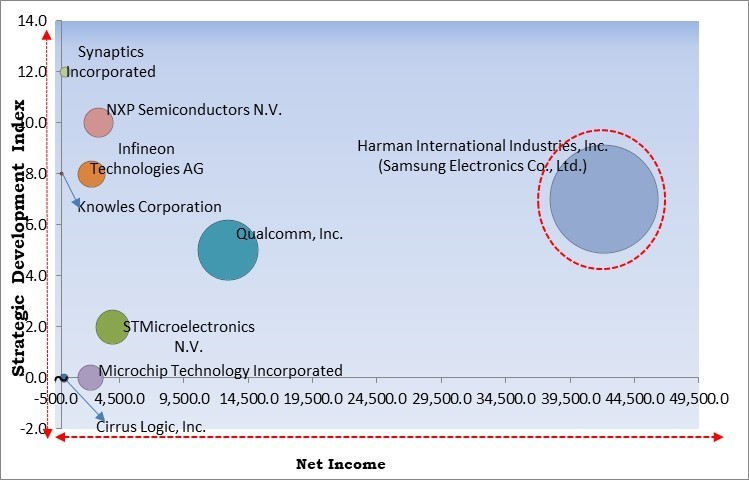
The ongoing development and integration of front-end hardware components greatly boost the far-field speech and voice recognition business. The performance and capabilities of front-end hardware, including microphone arrays and digital signal processors (DSP), significantly impact the accuracy of far-field speech recognition systems. These elements are necessary for limiting the effects of background noise and reverberation and achieving the highest accuracy and performance levels. Developing sophisticated noise cancellation and wind reduction algorithms leveraging beamforming technology is ongoing among processor and microphone manufacturers. The market is primed for growth as far-field speech and voice recognition technology accuracy continue to rise due to developments in front-end hardware components.
Voice recognition systems that can effectively understand and communicate in a wide range of languages and dialects are becoming increasingly necessary as multinational corporations spread their operations throughout several nations. This need includes hotels, e-commerce, contact centers, and customer service, where multilingual speech recognition helps firms provide individualized user experiences, boosting client pleasure and engagement. Voice-enabled technology is essential for assisting foreign passengers in the travel and tourism sector. Travelers' convenience and accessibility are increased by multilingual speech recognition systems' assistance with language translation, navigation, and local suggestions, for services like informative help, ticketing, and guest support, hotels, airports, and tourist attractions use multilingual speech recognition.
The market is constrained by the escalating privacy risks posed by voice-activated smart home appliances. Concerns about data privacy have mostly prevented people from using these gadgets. Users are becoming more distrustful due to the gathering and possibly exploiting their data. The market's potential for expansion is hampered by customers' reluctance to adopt far-field speech and voice recognition technology. Security flaws in voice-activated smart home gadgets further exacerbate threats to privacy. Companies may lessen the limitations created by the expanding privacy risks and promote greater adoption of far-field speech and voice recognition technology by tackling these privacy problems head-on.
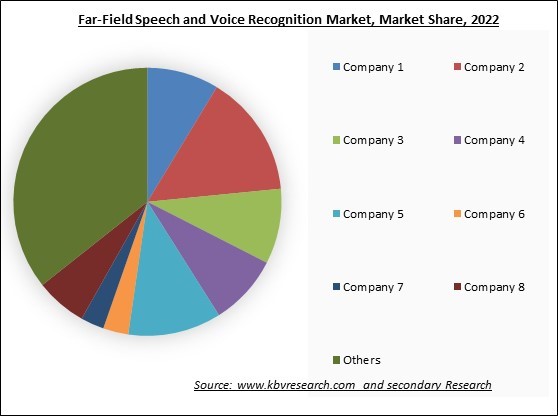
The leading players in the market are competing with diverse innovative offerings to remain competitive in the market. The above illustration shows the percentage of revenue shared by some of the leading companies in the market. The leading players of the market are adopting various strategies in order to cater demand coming from the different industries. The key developmental strategies in the market are Product Launches and Product Expansions.
By Offering, the market is segmented into microphones, digital signal processors and software. The microphones segment covered a considerable revenue share in the market in 2022. The microphones used by far-field speech and voice recognition systems use various technologies to lessen the effects of noise or reverberation. To enhance system performance, the microphone blends deep learning, MI, and AI. Using such technologies helps the market participant lower the number of microphones on the apparatus.
Based on application, the market is bifurcated into smart TV/STB, smart speakers, automotive, robotics and others. The smart speakers segment dominated the market with the maximum revenue share in 2022. Smart speakers are primarily driven by integration with voice assistants like Alexa and Google Assistant, as well as the growth of the IoT. Smart speakers are convenient and straightforward to use since they let users use voice commands to operate appliances, play music, and carry out other tasks.
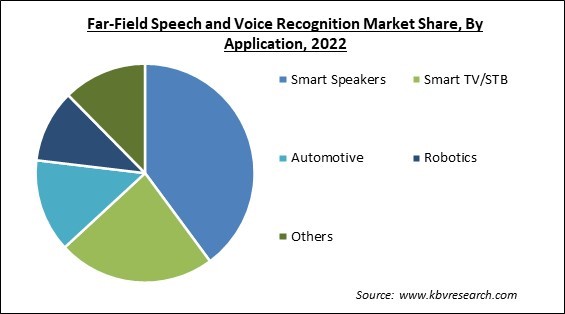
On the basis of microphone type, the market is fragmented into single microphone, linear arrays, and circular arrays. The circular arrays segment witnessed the largest revenue share in the market in 2022. Due to its capacity to record sounds from a complete 360-degree range, circular array microphone demand is anticipated to increase in the following years. They are thus the perfect option for big conference rooms, event venues, and other locations where attendees may be dispersed over a large area.
| Report Attribute | Details |
|---|---|
| Market size value in 2022 | USD 3.2 Billion |
| Market size forecast in 2030 | USD 9 Billion |
| Base Year | 2022 |
| Historical Period | 2019 to 2021 |
| Forecast Period | 2023 to 2030 |
| Revenue Growth Rate | CAGR of 13.8% from 2023 to 2030 |
| Number of Pages | 247 |
| Number of Table | 373 |
| Report coverage | Market Trends, Revenue Estimation and Forecast, Segmentation Analysis, Regional and Country Breakdown, Competitive Landscape, Market Share Analysis, Companies Strategic Developments, Company Profiling |
| Segments covered | Offering, Application, Region |
| Country scope | US, Canada, Mexico, Germany, UK, France, Russia, Spain, Italy, China, Japan, India, South Korea, Singapore, Malaysia, Brazil, Argentina, UAE, Saudi Arabia, South Africa, Nigeria |
| Growth Drivers |
|
| Restraints |
|
Region wise, the market is analysed across North America, Europe, Asia Pacific, and LAMEA. The North America region registered the largest revenue share in the market in 2022. The US and Canada have a disproportionate share of the area's far-field speech and voice detection market. The technical landscape in North America is powerful, and there is a significant concentration of big industrial participants. The market is growing due to the rising popularity of speech-activated virtual assistants, smart home gadgets, and the integration of voice recognition technology into automobile systems.
Free Valuable Insights: Global Far-Field Speech and Voice Recognition Market size to reach USD 9 Billion by 2030
The market research report covers the analysis of key stake holders of the market. Key companies profiled in the report include Andrea Electronics Corporation, Qualcomm, Inc., Cirrus Logic, Inc., Knowles Corporation, Harman International Industries, Inc. (Samsung Electronics Co., Ltd.), Infineon Technologies AG, Microchip Technology Incorporated, NXP Semiconductors N.V., STMicroelectronics N.V. and Synaptics Incorporated.
By Offering
By Application
By Geography
The Market size is projected to reach USD 9 billion by 2030.
Extending to international and multilingual markets are driving the Market in coming years, however, Threat to privacy restraints the growth of the Market.
Andrea Electronics Corporation, Qualcomm, Inc., Cirrus Logic, Inc., Knowles Corporation, Harman International Industries, Inc. (Samsung Electronics Co., Ltd.), Infineon Technologies AG, Microchip Technology Incorporated, NXP Semiconductors N.V., STMicroelectronics N.V. and Synaptics Incorporated.
The expected CAGR of this Market is 13.8% from 2023 to 2030.
The Digital Signal Processors segment is leading the Global Far-Field Speech and Voice Recognition Market by Offering in 2022 thereby, achieving a market value of $4.2 billion by 2030.
The North America market dominated the Global Far-Field Speech and Voice Recognition Market by Region in 2022, and would continue to be a dominant market till 2030; thereby, achieving a market value of $3.1 billion by 2030.
Our team of dedicated experts can provide you with attractive expansion opportunities for your business.
